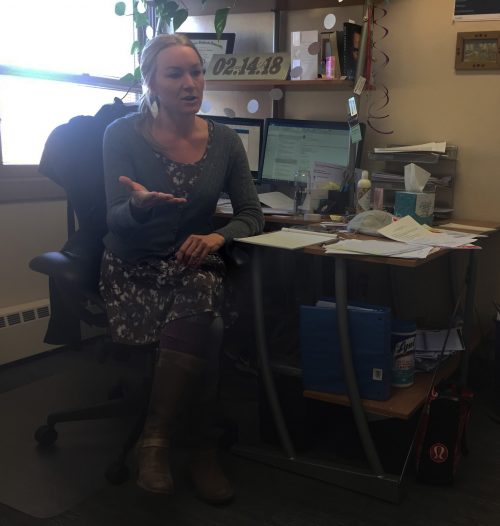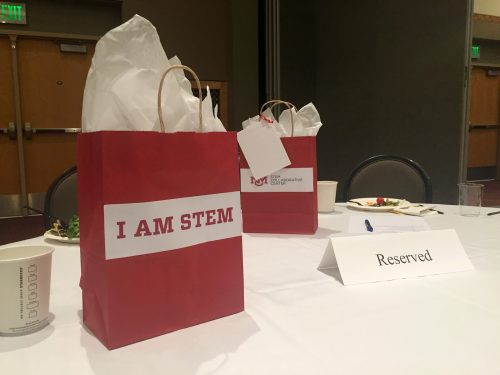The University of New Mexico has a lack of female faculty in science, technology, engineering and math fields. A survey of UNM departments reveals a disparity between male and female faculty members. This shortage of female professors is apparent in the science, technology, engineering and math (STEM) fields.

Of 12 STEM departments at UNM, the percentage of tenure-track female faculty (assistant, associate, full and distinguished professors) is only 24 percent. All of the departments had more male than female faculty.
The Department of Nuclear Engineering was the only surveyed department with no female professors, out of a total of six).
The data utilized was retrieved from the Sunshine Portal, a database that lists all UNM employees, their department, their position and their salaries.
The problem is not unique to UNM. Tara Hackel, the program specialist at the UNM STEM Collaborative, recalled her 2011 nuclear engineering class at the University of Michigan lacked female students.
“When I got an engineering degree, there was 10 percent women in my nuclear program,” Hackel said.
The School of Medicine’s Biochemistry and Molecular Biology is one of the most gender-balanced departments on campus, with 55 percent men and 45 percent women professors. The School of Medicine’s Molecular Genetics and Microbiology had 60 percent male and 40 percent female professors.
The rest of the departments surveyed range from 88 percent men in the Physics and Astronomy Department to 59 percent men in the Health Exercise and Sports Science Department.
![]()
Albuquerque resident Autumn Collins started at UNM as a counseling intern at Career Services. Today, she serves as a Career Counseling Manager at UNM’s Office of Career Services where she helps women plan their careers.

Collins said she has noticed the lack of women participating in STEM programs at UNM. She cites many factors but especially what she calls a long-standing culture of patriarchy— the dominance of men in the educational system.
“You have the white male dominant factor that is in every field, acting as a power structure,” Collins said.
Collins said there is complacency that exists in the United States.
“There is a culture of dominance that has been okay in a society, in a specific workplace, and in a specific field,” Collins said.
Hackel agrees that it is the current culture that explains the lack of women in STEM.
“From my personal experience, it’s not an interest issue…and it’s not an ability issue…it’s a culture issue,” Hackel said. “I think the culture of STEM is not inclusive for women both to feel respected as people but also to see their interests represented in options for jobs.”
Collins said UNM has been enhancing their support for women in STEM fields by taking aim at employers.
“Educating employers has been a really big step in my mind,” Collins said. “Educating employers on dismantling the culture of males being the dominant force or resource.”
UNM undergraduate student Emily Chavez is majoring in Biology with a minor in Psychology, pursuing a career as a physician assistant.
Chavez said she values leadership, life skills and creativity. Chavez gives UNM credit for its support of her and others.
“I have always felt supported as a woman pursuing a career in STEM at UNM,” Chavez said. “Despite what many would think, I typically have more female colleagues in my science classes.”
During her time at UNM, Chavez can cite a wide assortment of role models.
“I have also had strong female mentors to look up to in my professors, coaches, parents, and friends,” Chavez said. “Throughout my time at UNM, I have been fortunate enough to be surrounded by strong women and men who understand hard work and determination is determined by everything but sex. I have always felt encouraged and supported to achieve my goals.”
Hackel also emphasized the importance of mentoring women in STEM fields. She points to the UNM STEM Mentoring Program, which helps female students in STEM fields learn how to get internships and negotiate salaries, and to become leaders in their communities. They can then begin fostering more inclusive spaces, Hackel said.
One of Chavez’ goal for women in STEM fields is to see them believe in their ability.
“I want to see women continue to stick up for themselves and encourage the empowerment of other women,” Chavez said “As a woman, chasing after something that is male-dominated can be challenging. Support from other women experiencing those same challenging obstacles and thoughts can go a long way and it should be encouraged.”

Hackel believes that STEM fields need professors and faculty members who welcome diversity in such fields, which may lead to women feeling more supported.
“We need leaders in front of the classroom who value women being there, who value people of color being there, who value people from diverse experiences being there,” she said.
Hackel has also seen a shift in culture, particularly at UNM. People are now more willing to challenge these issues head-on.
“We actively talk about the barriers that students are facing and we problem-solve how to address them,” Hackel said. “So, it’s less of a ‘that’s-just-how-it-is’ culture. I see more of a ‘here’s all the tools we have to do something about it.’”
UNM continues to push towards becoming a more inclusive school. The latest example is the new Division of Equity and Inclusion Task Force Report that came out in December 2017. It emphasizes bringing more diversity into all areas of UNM, including STEM fields.
Hackel acknowledged that no matter the disparities, women are not going anywhere in STEM fields.
“Women are here, we’re good at it, we like it, we’re going to keep trying to do it,” she said.
Sarah East and Aleks Mihailovic can be contacted on Twitter at @saraheast67 and @aleksmihailovic.